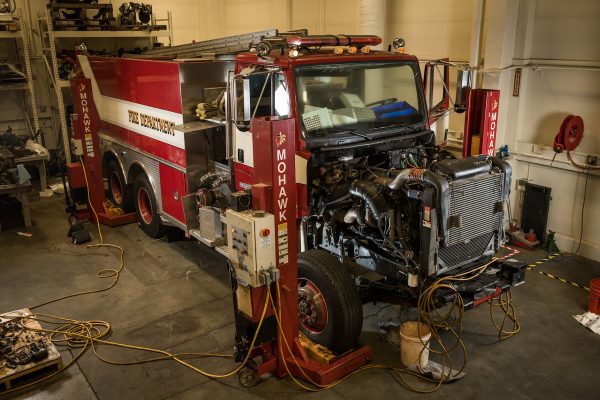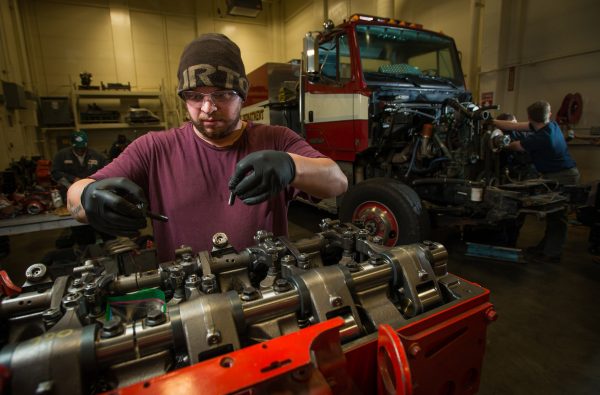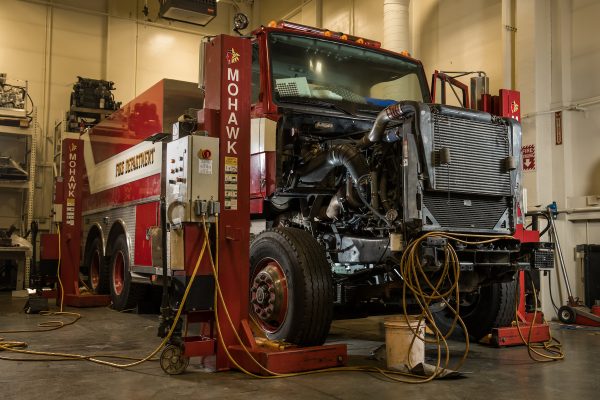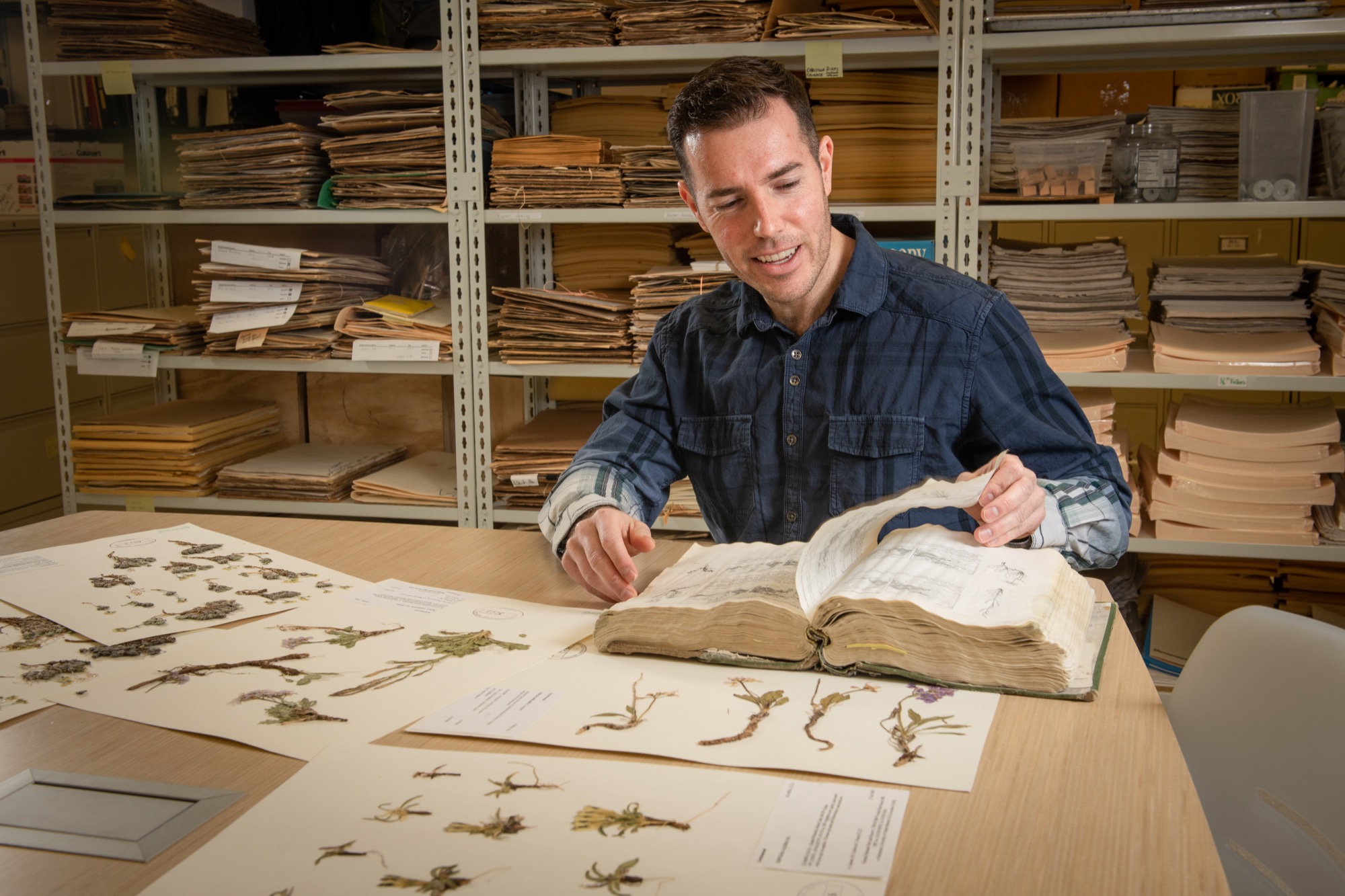Smoke and gears
by joey |

For the past three semesters, diesel power technology students have worked on this donated fire truck bound for the Seldovia Volunteer Fire Department. (Photo by James Evans / University of Alaska Anchorage)
For the past three semesters, diesel power technology students have been busy fixing a donated fire engine in the UAA garage. So while some students claim their class projects are life-or-death, this one actually qualifies.
"Every piece has to work together perfectly or else you have a catastrophic failure," said Ben Stewart, a diesel student who worked on the fire engine.
The stakes are high because the donated truck will return to service with the Seldovia Volunteer Fire Department. It's a beneficial partnership: students gain valuable experience, while a small community gains a valuable emergency vehicle.
"These are great real-world projects for our students," noted Darrin Marshall, director of the Department of Automotive and Diesel Technology.
The engine in question originally served the Anchorage Fire Department until it overheated at a rescue call. Department mechanics determined that, in a city with nearly 300,000 tax payers, it was better to replace the older engine than repair it. A community like Seldovia, though, with 0.1 percent of Anchorage's population, would really benefit from a donation like this.
So Anchorage Fire mechanics reached out to the university and designed a plan: the Seldovia Volunteer Fire Department would pay for parts and receive the pump truck ready to roll, but on a timeline that benefited UAA students.
Since fall 2017, three classes - sections of Medium/Heavy Duty Engines and Heavy Duty Diesel Engine Performance - have worked on the project. Typically, students in these classes work on controlled engine demos, where professors control the problems for students to solve. But the pump truck arrived with no instructions. Students could feel air squeezing out a hole in the radiator, and knew the engine had gushed white smoke at a recent rescue run. That's it.

Greg Perez, a diesel power technology student, works on an engine during a fall 2017 class. (Photo by James Evans / University of Alaska Anchorage)
Throughout the diagnosis, students decided how to approach the problem. Remove the transmission or leave it? Take out the Detroit 60 engine - which weighs as much as a standard car - or work in-chassis? Keep in mind, all the parts removed had to be replaced. Perfectly.
"At times it was frustrating," Stewart said of the class project. "100 nuts and bolts out of the cab just to get to the pump, then get the bolts, then lift it straight up."
Unlike a demo, the live project came with nooks and crannies. On the older vehicle, one problem often led to three more. Students snaked tools around brackets and wedged bodies behind wheels to reach the right part.
"You're literally tackling the truck," one student noted.
"It was just a rat's nest of crazy," added another.
With only a few hours of class time to work each week, students slowly discovered the problem - a cracked cylinder liner - and worked on repairs.
Within the diesel program, the pump truck gave students immediate career experience. Most students involved were first-semester freshmen, younger than the engine itself. But in their first week on campus, they were already working on a project with consequences beyond the garage.
Having first-year students work on the live project added significantly to the repair timeline, but the challenges were worthwhile, said Darrin Marshall: "High risk brings the high reward of graduating students with the confidence of being able to fix any diesel in industry; marine, mining, electrical generation, construction, over-the-road heavy-duty."
And, importantly, it gave students a brush with catastrophic failure.
"These engines bring the stress of knowing one mistake can bring failure on the whole project," Marshall said.
Thankfully, that never happened. Now, the department is waiting on a few necessary parts to install before shipping the truck to Seldovia. And all it took was tenacity, elbow grease, dozens of diesel students and three semesters tackling the truck to untangle the rat's nest.

The Detroit 60 Diesel engine, described by one student as "A rat's nest of crazy." (Photo by James Evans / University of Alaska Anchorage)
Across the garage, diesel students also repaired a snowcat for volunteer-run Arctic Valley Ski Area. Click here to read more.
Learn more about the diesel power technology degree program.
Written by J. Besl, UAA Office of University Advancement
 "Smoke and gears" is licensed under a Creative Commons Attribution-NonCommercial 4.0 International License.
"Smoke and gears" is licensed under a Creative Commons Attribution-NonCommercial 4.0 International License.














